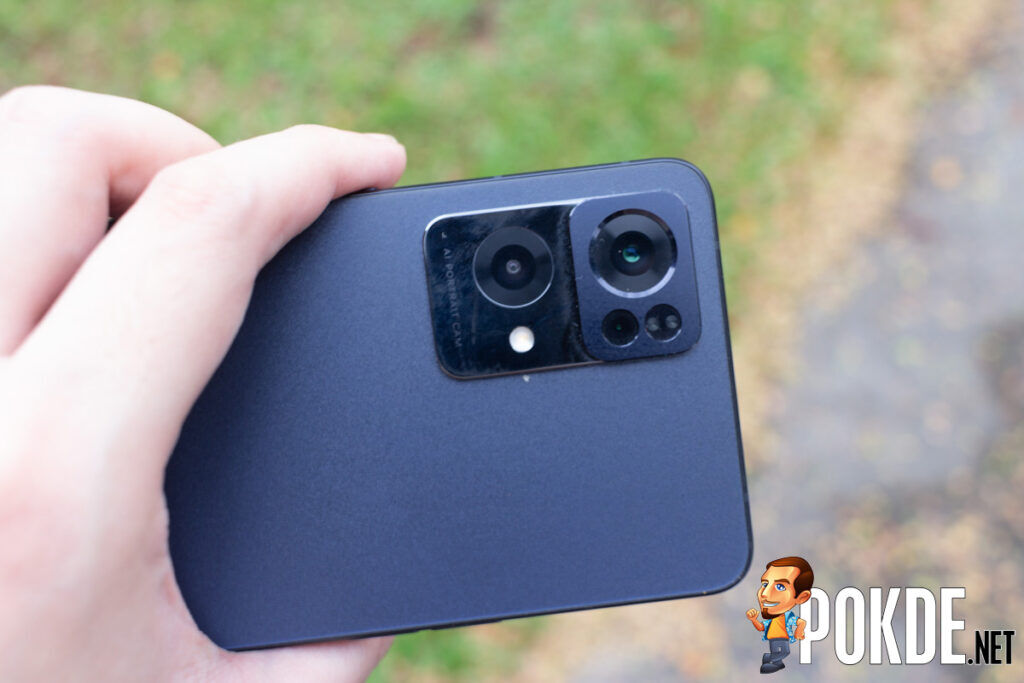OPPO Reno7 Pro Review — Flaring Up Your Bokehs
-
Appearance - 7.3/10
7.3/10
-
Efficiency - 7.9/10
7.9/10
-
Features - 7.8/10
7.8/10
-
Materials - 8.4/10
8.4/10
-
Performance - 7.5/10
7.5/10
-
Portability - 7.6/10
7.6/10
-
User Experience - 7.3/10
7.3/10
-
Value - 6.5/10
6.5/10
Summary
The OPPO Reno7 Pro looks cool and performs decently but shows little improvement from its predecessor.
Overall
7.5/10Pros
+ OPPO Orbit Breathing Light looks cool
+ Smooth AMOLED display with 90Hz refresh rate
+ Dual speakers onboard
+ Nice matte finish at the back
Cons
– Not for those who dislike flat sides in a smartphone
– Could’ve used a better chipset for the price
– Mixed feelings on the bokeh
– Bloatware
We got our hands on the recently released OPPO Reno7 series, specifically the Pro version. So what exactly does it bring? Here’s our OPPO Reno7 Pro review and our thoughts on it. It’s worth noting that we received the device without the full packaging, so we’d need to skip a few parts that we’d normally include for our reviews. Let’s get started, shall we?
Appearance
Starting with the front, you get a 6.55-inch AMOLED display with 90Hz refresh rate support. As you can see, the smartphone has a punch-hole camera at the top left for your selfies. The first speaker is located in the middle top of the display as well, just in case you can’t see it.
The sides of the smartphone are completely flat and the volume rockers are located on the left hand side. As for the opposite right, there’s only the power button available.
Down below is where you’ll find the SIM tray, microphone, USB-C port, and secondary speaker.
As for the top, there’s only the secondary microphone to be found.
Flipping over to the back, you can see that we have the Starlight Black variant of the device. It comes in a nice matte finish and the camera is positioned at the top left with two cutouts. You’ve probably seen it by now but here’s also where the ‘Orbit Breathing Light’ magic happens.
OPPO Reno7 Pro Specifications
| CPU | Dimensity 1200 Max, 6nm FinFET 1 x Cortex-A78 @ 3GHz + 3 x Cortex-A78 @ 2.6GHz + 4 x Cortex-A55 @ 2GHz |
| GPU | ARM G77 MC9 |
| Memory | 12GB (up to +7GB through RAM expansion) |
| Storage | 256GB UFS 3.1 |
| Display | 6.55″ FHD+ (2400 x 1080) AMOLED display, 90Hz refresh rate, HDR10+, Corning Gorilla Glass 5 |
| Audio | Dual speakers |
| Camera | 50MP f/1.8 main camera, PDAF 8MP f/2.2, 119-degree ultra-wide 2MP f/2.4, macro Color Temperature sensor AI Camera, Bokeh Flare Portrait, Auto HDR, Pro Mode, Beauty, Panorama |
| Selfie camera | 32MP f/2.4 selfie camera |
| Connectivity | WiFi 802.11 a/b/g/n/ac/ax Bluetooth 5.2 USB Type-C 2.0 |
| Software | MIUI 12 based on Android 11 |
| Battery | 5000mAh 65W fast charging |
| Dimensions | 158.2 x 73.2 x 7.5 mm |
| Weight | 180g |
| Ingress protection | N/A |
Performance
Kicking off the benchmark suite with Antutu V9, we can see that the new Reno7 Pro failed to beat its predecessor, which uses a Snapdragon 870.
We see a similar result over on Geekbench 5, where both single core and multi-core tests showed how the Dimensity 1200 doesn’t bring much to the table.
In terms of graphical performance, the trend continues here as well. That being said however, it’s a decent score for a mid-range device.
Continuing on with PCMark Work 3.0, we see a drop on the list, again, going lower than the scores of its older brother.
We see a change of direction when it comes to the battery department however as the phone lasted 688 minutes in the test. As for real-life usage, I find no problems where it would last me around 2 days of my normal use before I need to look for a charger. You could expect a longer battery life should you lower the refresh rate.
User Experience
When I first held the smartphone in my hands, the first thing that comes to mind is that “this feels like an iPhone”. How so? Thanks to the flat sides. You might however be a fan of it, should that be your design of choice but I’d rather have curved edges which feels more premium to me, similar to their previous OPPO Reno6 Pro.
The screen offers a similar experience with its predecessor where it’s visible even under direct sunlight and it’s helped with a 90Hz refresh rate. No complaints from me on that end. What they did improve on however is the addition of a secondary speaker. It’s just simply better than just a single source of audio pumping out.
The first time that I saw the Orbit Breathing Light for the series, I thought to myself that “this looks cool” but then I just realized something. Now this is a subjective matter but I find the lighting at the back to be… impractical. With the feature, it lights up when you have a notification or even when you charge your device. For me personally, I tend to put my device down with the screen facing up, so the feature is kind of pointless to me. Different use cases could benefit more from it.
The phone runs on ColorOS 12 based on Android 11. If you’ve used the skin before, you can expect a similar experience. I had no issues with it, thanks to its 12GB RAM and 90Hz refresh rate. If there was one thing that I would complain here is that there’s bloatware in the home menu. While I do understand why some brands decided to put them in, it’s not something that you’d typically expect from a device in its price range.
 The camera UI is also a similar experience. Everything is viable and if you don’t fancy the modes that’s given to you (at the home menu), you can simply customize it to your liking, which is always nice. There are no issues of sluggishness as well when it comes to taking shots.
The camera UI is also a similar experience. Everything is viable and if you don’t fancy the modes that’s given to you (at the home menu), you can simply customize it to your liking, which is always nice. There are no issues of sluggishness as well when it comes to taking shots.
Shots in good lighting are pleasing enough, where colours look vibrant and it comes with a good dynamic range. Low-light shots are also decent and you can definitely see the difference that Night Mode provides.
The dual portrait camera at the front with uses a Sony IMX 709 sensor is actually good in taking selfies, even in low-light conditions I would say.
Then you have the Bokeh Flare Portrait, which was previously found in the OPPO Reno6 Series as well. It seems that they’ve fixed the focusing now as it is more consistent. While I’m not a fan of the bokeh (as it looks unnatural), there could be those out there who would fancy such an effect.
You can check out the full-sized images by heading to the link right here.
OPPO Reno7 Pro Verdict
Is the OPPO Reno7 Pro a decent smartphone? Yes, it is. Is it worth the asking price of RM2,999? Well that really depends on what you’re looking for. I wished that they’ve had at least utilized a better chipset for starters. I’m not saying that the Dimensity 1200 Max is bad, but for that price, you’d expect something better.
Other than that, the upgrade compared to the previous Reno6 Pro is quite minimal. That being said, if you don’t mind some of the subjective points that I’ve mentioned earlier and you enjoy having a flashy smartphone, go for it.
We would like to thank OPPO Malaysia for providing us with the OPPO Reno7 Pro that was used in this review.




























































